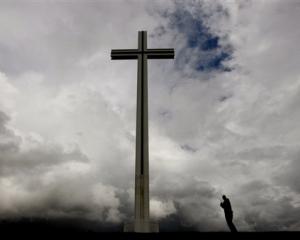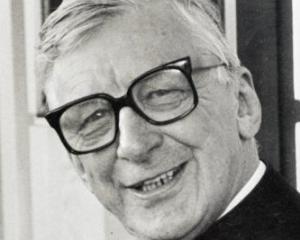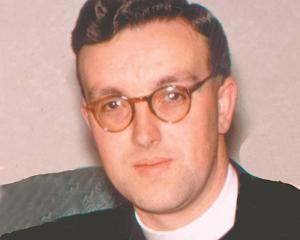When the earth heaved in Kaikoura, Otago Daily Times reporter Chris Morris was soon on a plane heading north. And, amid the aftershocks and uncertainty, he found inspiration in the relief effort.
There are many sights from the Kaikoura Earthquake that tug at the heart strings.
The distraught woman evacuated from Goose Bay, who staggered out of a helicopter in Cheviot and sank into the grass to shed tears of trauma and relief.

The look on people’s faces as they stared up at a helicopter passing overhead, wishing they were on it.
Or the way traumatised people suddenly grabbed each other and leapt away from the shadow of a building when another aftershock jolted the town.
But, more than anything, what brought a lump to my throat — after two days observing the aftermath of Kaikoura’s magnitude 7.8 earthquake — was an overwhelming sense of pride.
Pride in the way Kiwis stepped up when disaster struck, going above and beyond to help each other and the international guests that looked to them for help.

Disasters can bring out the best in people, and never was that more evident than in the days after Monday’s jolt.
I left Dunedin to cover the story for the Otago Daily Times on Monday morning, flying to Christchurch and then driving to Cheviot, where the route north on State Highway 1 ceased to exist.
After interviewing escaping tourists as they spilled off incoming helicopters, I managed to secure a seat on one heading north the following day.

As the helicopter descended into Kaikoura, I caught my first glimpse of hundreds of tourists, clustered in a knot of tents, rental cars and campervans around Kaikoura’s hospital.
And, as their faces turned to look up at the new arrival, I was struck by a sense of guilt — a helicopter bringing in another journalist, when all they wanted was some water and a way out.
Thankfully, the reception was anything but hostile, as tourists and locals alike shared their stories of terror and their gratitude for the disaster relief effort that followed.
Examples were everywhere, from the helicopter crews who flew endless missions taking supplies in and tourists out, to the volunteers who helped stock the machines and comforted those escaping the ordeal.
Then there were the locals who realised the volunteers needed food, too — even those working in a Cheviot field — and set about making sure they got it.
In Kaikoura, everyone had a job to do as the town swarmed with people determined to help — emergency services, military personnel, Civil Defence, Red Cross and council staff among them.
The soundtrack was the constant roar of helicopters passing overhead, scurrying from one community in need to the next, or kicking up powerful gusts of wind as they landed in the centre of Kaikoura.
But the epicentre of kindness had to be the Takahanga Marae, which opened its doors to serve up hot, nourishing meals — or give a bed for the night — to thousands of people with nowhere else to go.
The queue for food stretched out the gate and down the road at times, as utes with trailers arrived piled high with whatever food could be found.
They were unloaded by volunteers and the food rushed to the kitchen, where dozens more people helped prepare, cook and serve it up to the never-ending stream of the needy.
But the marae was not alone, as churches, commercial accommodation providers and individual homeowners also opened their doors to strangers.
On Tuesday, after sending my day’s work back to Dunedin, my thoughts turned to where I was going to sleep for the night.
Helicopters Otago had agreed to get me to and from Kaikoura, but — quite rightly — the trip turned into a one-way ticket when the crew was asked to carry on to Wellington for more urgent work.
That was when Don appeared.
The laughing, joking retiree from Christchurch had children in Kaikoura, and also a small beach hut — with four beds — near the coast at South Bay.
After Monday’s earthquake, he had flown to Kaikoura in a friend’s helicopter to evacuate his children, but then decided to stay behind and help.
And, as I contemplated the comfort of grass or a bush, Don grinned and offered me his hut.
Eventually, after also rounding up a British couple who had been sleeping in their car, we headed back to Don’s place, which still showed signs of Monday’s earthquake.
A fridge had marched across the floor, pictures hung at crazy angles, and broken glasses and the contents of cupboards were everywhere.
We tidied while Don disappeared, insisting he find us water to boil on the gas stove and milk for a morning cup of tea. He returned with the goods and then left us for the night, saying he would stay elsewhere and insisting we help ourselves to anything and stay as long as we wanted.
And, as aftershocks rattled through every 10 or 15 minutes, the shaking was magnified because the hut remained on the wheels once used to roll it into position.
But any nervousness about another tsunami was eased by the existence of an escape route — a steep bush track behind the cabin, leading to high ground, which we hoped would not be needed.
There were further reasons to hope the next morning, when the unmistakable blob of the HMNZS Canterbury appeared on the horizon, steaming to the rescue.
The military evacuation that followed was impressive — helicopters overhead, rigid inflatable boats and a landing craft in the water, ferrying tourists to safety.
Civil Defence controller John Mackie — a former Dunedin City Council manager — described the operation as a "big push", and, with a flotilla of international warships joining the relief effort, it really did feel like an invasion of kindness.
But a walk from South Bay to the northern outskirts of Kaikoura also revealed more evidence of the quake’s power.
Roads were cracked in places and, although most homes appeared unscathed from the outside, things got worse further north — battered homes, cracked sections, buckled fences and wooden boards where shop windows had exploded.
Mitre 10’s concrete and timber facade had peeled off and collapsed into the store’s car park, while a nearby bridge had been torn apart.
Most businesses remained closed, and a few taped off, in once-busy shopping streets now almost devoid of people or cars. One of the few that was open was Kaikoura’s New World, where groceries had been jumbled together in shopping trolleys at the front of the store.
Water and milk were strictly rationed, but one staff member joked she was thinking of taking up smoking instead. Others spoken to said problems only got worse in outlying communities and farming areas.
One man told of a neighbour who had bush-bashed for two days to reach Hapuku, north of Kaikoura. The man’s house had been torn in two by the quake, leaving him in one section and his children in the other.
Others spoke in awe of the power of the quake to lift the foreshore and even reshape well-known mountain faces. And, as we talked, a team of building inspectors, urban search and rescue staff and army personnel went door-to-door, checking and stickering buildings according to their risk.
Then, after talking to Otago people caught up in the quake, and with the last 700 tourists wanting out expected to be gone by nightfall, it was time to plan my own exit.
I managed to secure a seat in a helicopter heading south. The helicopter circled over small settlements in Goose Bay and Oaro, before swooping down to land, deliver medicine and check on those who remained.
Then it was on to Cheviot to land, with just time for a quick handshake before the helicopter roared off again.
And, as I drove back towards Amberley — exhausted, sunburnt and smelly — I only had one regret.
I left a note in Don’s beach hut saying I’d be back to stay that night.
It should have just said "thanks, mate".











